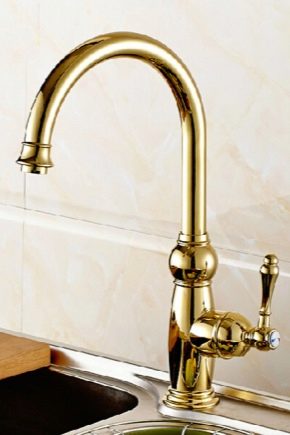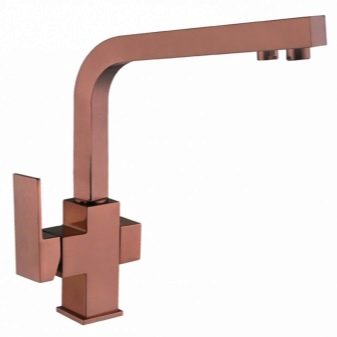How does the mixer work?

The faucet is an important plumbing element in any room where there is a water supply. However, this mechanical device, like any other, sometimes breaks down, which requires a responsible approach to the selection and purchase of a product. In this case, its features and design direction should be taken into account in order to choose the most suitable option.






Peculiarities
The mixer is used for mixing water. The device is connected to the water supply (cold - cold water supply and hot - hot water supply), and subsequently it removes liquid in the required amount. The regulation of the temperature and water pressure of the supply is completely dependent on the wishes of the user.
Modern mixers are made from different materials:
- metal (bronze, brass and silumin);
- polymeric;
- ceramic.

Metal models are very popular. Even with constant contact with water, brass and bronze alloys are not prone to oxidation and are resistant to corrosive changes. Each material is chemically neutral, and therefore no mineral-salt plaque is formed on their surface. They are distinguished by high performance characteristics and, with proper care, have a very long service life. Silumin alloy (silicon + aluminum) does not differ in reliability and durability. Most often, inexpensive Chinese or Turkish models are made from it, which, having a low cost price, still gained favor and popularity among consumers in the plumbing market.
Polymer faucets are much cheaper than metal ones, and the manufacturing process is not complicated. Plastic is also not affected by the mineral composition of water, and due to its low thermal conductivity, it is more practical to use it at high temperature indicators.



The most significant drawback of this material is its fragility. That is why it is extremely rare to make important structural parts from polymers and is more often used to create control levers and flywheels.
Ceramic mixers are a time-tested material, which is successfully used today. However, modern models, for example cermets, are more improved and contain some kind of metal alloy. Ceramics are also resistant to corrosion and mineral salt deposits. Nevertheless, ceramics and cermets are fragile materials that can deform from a careless impact or too high water temperature. Therefore, they try to combine them with other materials, for example, brass.

The material from which the mixer is made is responsible for the technical side of the device. The coating provides an attractive appearance and protection.
The coating can be made from:
- vacuum spraying (PVD);
- chromium;
- bronze;
- nickel;
- enamels;
- powder paint.
PVD is the most expensive but the toughest coating. It will provide a long service life even in the most extreme conditions, protect against any scratches and abrasions. Powder paint is also durable, aesthetically pleasing and expensive. It undergoes high-temperature processing - about 200 degrees. Thanks to this, the paint is securely fixed to the surface.


The most common and demanded coating is chrome.Chrome plating is inexpensive, but extremely effective spraying to maintain the integrity of the material, with an attractive look. Chrome can be glossy or matte. The main thing is that the chromium layer is at least six microns, otherwise it will quickly be erased.
Constructions
Among the wide variety of models, the main types of mixer designs are distinguished, which have both their advantages and disadvantages.

Single-lever
A single-lever or multi-command mixer has a single functioning knob that regulates the degree of water pressure and its temperature.
Characteristics:
- The principle of operation lies in raising or lowering the lever, the higher the lever is understood, the stronger the pressure.
- By turning left or right, the required temperature is set.
- The fully lowered lever completely blocks the water.
The mixers are equipped with so-called cartridges of two types. The first type is ball devices, they have a ball-shaped adjusting head, which is made of steel. The second type - ceramic - looks like two metal-ceramic plates tightly pressed against each other. The cermet is subjected to ultrasonic grinding, and this ensures a perfect fit of the plates, which retains water and prevents it from spilling.

Two-valve
The scheme of two-valve devices includes a valve - axle box or valve head. This element regulates all water characteristics. The presence of a small chamber in the building ensures the mixing of cold and hot water, and there is a mesh on the spout of the faucet to prevent splashing.
Characteristics:
- To attach the structure to the water supply, you need to use the retaining elements - eccentrics, and for connection - steel corners.
- The underwater pipes must be 15-16 cm apart, otherwise the installation of the mixer will fail.
- Of the entire structure, the main constituent elements are two valve-type heads. The service life of the mixer depends on their quality.


To prevent leaks, the joints are sealed with rubber gaskets, O-rings on a plastic or rubber base. However, for the correct and long-term operation of the device, these elements must be changed from time to time.
The design diagram of a two-valve mixer consists of:
- a chamber in which cold and hot water is mixed;
- switch (type - slide valve);
- eccentric;
- spout with mesh (not always present);
- a decorative flange that disguises the area of connection of the water supply system to the mixer;

- rubber seals;
- valve heads;
- pens.
Thermostatic
Thermostatic mixers are modern technological models that are quite convenient to use and do not bring any hassle.
Let's consider the characteristic features.
- To regulate the pressure with temperature, you do not need to turn the knobs. There is a special temperature scale on which the required degree is set and the fastening adjusting screw is activated.

- It seems possible to set the degree as accurately as possible. The temperature adjustments made will not affect the central water supply in any way, since the changes are localized.
- Thanks to a special safety system, the risk of thermal burns is minimal.
The work of this design is provided by a cartridge, which contains a bimetallic base and wax. The base is very sensitive to temperature changes, and the cartridge, expanding and contracting, is able to quickly respond to fluctuations in water temperature.

Non-contact or touch
These devices are extremely rarely used for domestic purposes, most often they are installed in public places with a large flow of people. Thanks to infrared rays, internal sensors respond to the approaching hand, its warmth and movement, and immediately turn on, supplying water.They can be adjusted for the duration of the fluid supply and its temperature, however, these indicators are already set by the manufacturer as standard, and it is not advised to change them.


Additional functionality
The differences in the type of construction are explained by the fact that mixers can be completely different models. Additional functionality allows you to find the perfect and comfortable crane, which may include:
- high spout (gander);
- the possibility of turning the crane;
- the possibility of directing a stream of water to the center of the sink;
- retractable hose.
The gander height is the shortest distance between the base and the water outlet. The low spouts are 15 cm, and the middle ones are from 15 to 25 cm. These taps are chosen when the sink is used only for washing and other hygiene procedures. These models are combined with shallow, narrow and flat shells.

High spouts from 25 cm allow, for example, to draw tap water into large containers. The sink in such cases should be deep and wide to avoid splashing water throughout the room. The mixer must be of such a length that the jet does not hit the walls of the sink, but falls exactly into the drain valve, since deposits quickly form on the walls.
The swivel spout allows the tap to be rotated after installation, which is very convenient in some situations. The advantage of this modification is that it is easy to operate, its service life is about ten years, and the surface of the mixer is minimally contaminated. The disadvantages include a high level of sensitivity to the purity of water and the presence of impurities in it, as well as the weak strength of the mobile body itself, which, if the gasket breaks, requires a complete replacement.



The retractable hose in the mixer turns the tap into a very practical and mobile device. The supplied hose is tightly braided with metal threads, which protect it from mechanical damage. This option is inexpensive, but with the right choice and installation, it will last a very long time. It is also worth noting the switching of water from a direct stream to a drip mode and an additional outlet for filtered water.
Tips & Tricks
The mixer is under tremendous stress. Therefore, in order for it to last as long as possible, it is important to choose the right device, taking into account some of the nuances. The focus of work should be separated - separately for the sink in the kitchen and for the sink in the bathroom.
In the kitchen, the device is exposed to a lot of stress, especially if the household often cooks. Washing dishes, rinsing hands, filling the kettle and other regular procedures are accompanied by the constant opening and closing of water. Based on this, the mixer should be practical in handling, reliable and durable.

Experts prefer single-lever designs that can be opened even with an elbow, because they are easy to turn. It is better to choose a mixer that is rotatable rather than fixed. The choice of the owner is influenced by the presence of a high spout and a pull-out hose.
There are no special recommendations for the bathrooms, the choice of the mixer is completely focused on the wishes of the owner and the characteristics of the room. Both single-lever and two-valve models are suitable here. For small spaces, the combination of a bath mixer and a washbasin is perfect. They have long swivel spouts and a switch (for example from a button) to redirect water to the shower head.


Before purchasing, it is important to know exactly whether the installation can be carried out. It can be open or hidden, mounted on the side of the bathroom or wall surface. If you do not have a shower cabin, you can install a mixer with a shower switch, a hose with a hand shower and a holder. Today, there are designs without a spout, where water goes directly to the shower head.
Based on the locking mechanisms, it is better to choose two-valve mixers with ceramic discs. They are more durable, and it is much easier to set the water temperature on them. When choosing a lever device, both ball and ceramic types are equally reliable, but ball ones are quite noisy. However, they are easier and cheaper to repair.
For information on how to choose a mixer, see the next video.













The comment was sent successfully.